The Angelbird Wings PX1 M.2 Adapter Review: Do M.2 SSDs Need Heatsinks?
by Billy Tallis on December 21, 2015 8:00 AM ESTMixed Random Access
Instead of testing a range of queue depths, our mixed workload tests vary the proportion of reads and writes while using a constant queue depth. The test begins with pure reads, then incrementally shifts toward pure writes with three minutes for each subtest. As more writes come in to the mix, the odds increase that a read request will be held up by one of the flash chips being busy with a longer-duration write. Likewise, having lots of reads in the mix can limit the drive's ability to combine writes into larger batches. Thus, the worst performance on these tests usually occurs somewhere around the middle. To approximate client workloads, the mixed random access test uses a queue depth of three and like the random write test it is restricted to a 16GB portion of the drive.
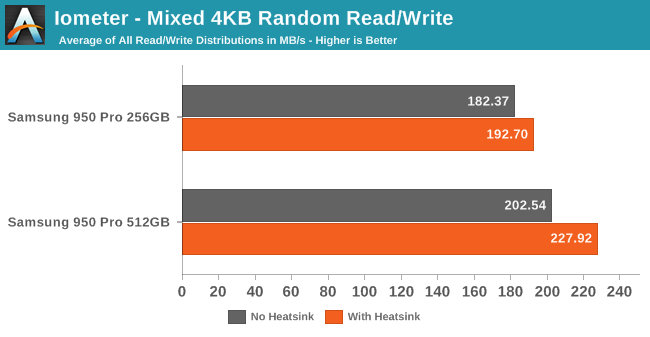
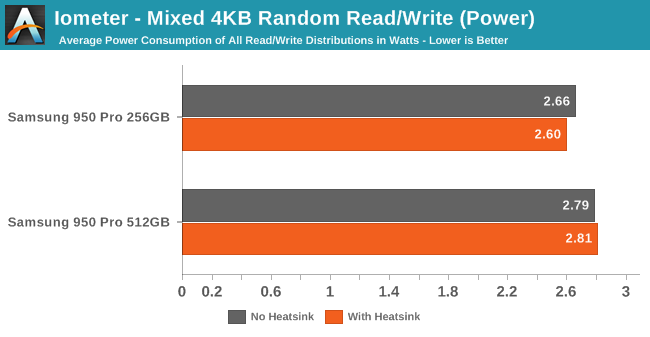
The mixed workloads were the only tests where the two capacities showed significant performance differences even without the heatsink, indicating that thermal throttling was much less of an issue for the 950 Pro here. The heatsink still helps, but only slightly. Given how random reads were essentially unaffected by the heatsink, it's a bit of a surprise that the writes improved by enough to bring the average up by 12.5% for the 512GB drive.
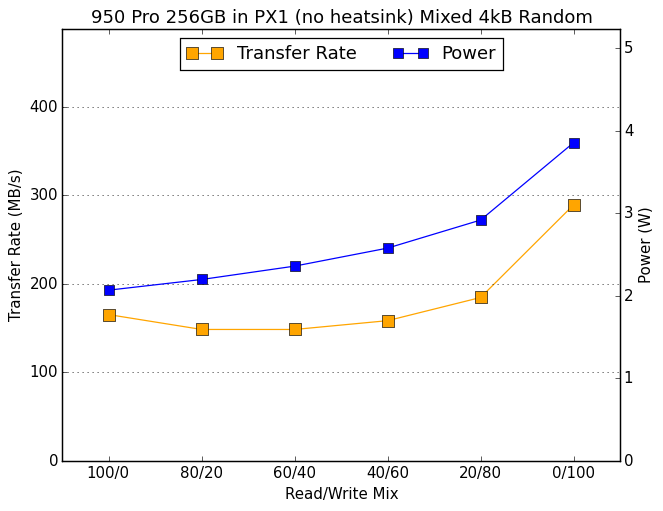 |
|||||||||
| 256GB no heatsink | 512GB no heatsink | ||||||||
| 256GB with heatsink | 512GB with heatsink | ||||||||
Almost all of the performance improvement with the heatsink comes at the very end of the test as it shifts to pure writes. Performance earlier in the test is virtually unaffected by the heatsink, but power efficiency does see the slight improvement from lower operating temperature.
Mixed Sequential Access
As compared with the mixed random test described above, the mixed sequential test differs by using a queue depth of one and by requesting larger chunks of data. This test operates across the whole drive, which is pre-filled with data.
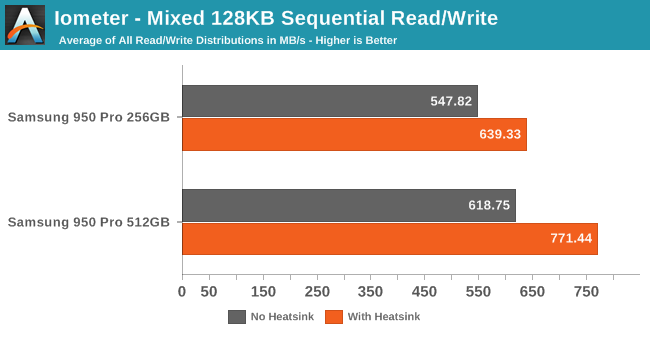
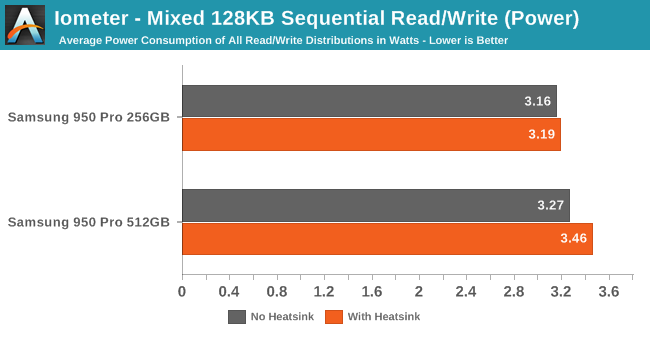
Both of the previous sequential performance tests showed huge improvements even at low queue depths, so it's no surprise to see a significant improvement in a mix of the two.
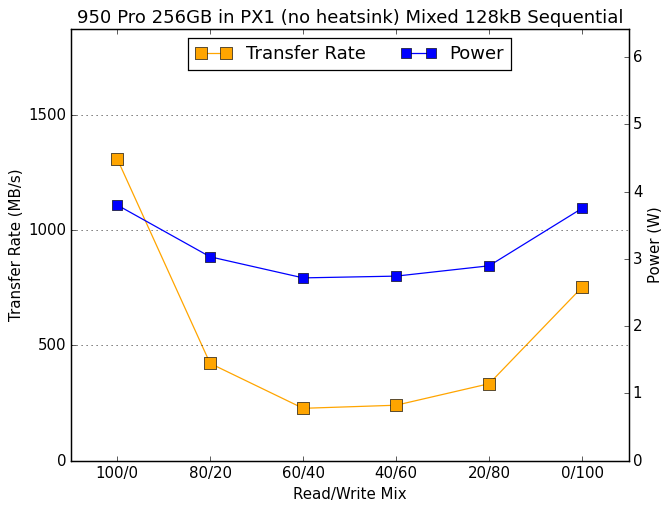 |
|||||||||
| 256GB no heatsink | 512GB no heatsink | ||||||||
| 256GB with heatsink | 512GB with heatsink | ||||||||
A closer look reveals that the overall performance improvements are once again attributable to the non-mixed segments of the test. Unlike the mixed random test, read speeds are part of the improvement here. But on the sub-tests with a balanced mix of reads and writes, the 950 Pro wasn't throttling even without the heatsink.










69 Comments
View All Comments
Billy Tallis - Monday, December 21, 2015 - link
Unfortunately, the only high-quality thermometer I have is the temperature probe for the multimeter that was busy doing the power measurements. I'll be getting some kind of thermometer soon, and I'm open to suggestions of something with data logging capability. Otherwise I'll get a cheap IR thermometer and you'll have to be satisfied with just a few spot readings instead of the full graph we'd both rather see.defaultluser - Monday, December 21, 2015 - link
I wonder if you could compare the performance of this heatsink versus just pointing a quiet 80mm fan at the drive? More moving air can have the same effect as much larger surface area, especially if we're only talking about half a watt extra required to reach full performance.ronboberg - Monday, December 21, 2015 - link
So, basically they just need an extension cable/riser for the M.2 slot (they can do it for normal pci-e slot, these are basically the same thing but smaller) so you can relocate the drive in a normal drive bay to keep it cooled off. Or if they started out with something like a real cable going to a slightly modified M.2 connector that would be purposed for just drives on the board in the first place they could make normal 2.5" size drives with the new connector, 2TB+, and all the advantages that goes with being bigger and able to be placed like a normal drive. If you don't have the space, the small boards could still have the universal M.2 slot they have now for the bubblegum stick size drives but would just have to put up with the heat.extide - Monday, December 21, 2015 - link
We already have what you are asking for: U.2tipoo - Monday, December 21, 2015 - link
I wonder how this compares to just slapping these on the relevant chipshttp://www.newegg.com/Product/Product.aspx?Item=N8...
Zak - Monday, December 21, 2015 - link
As few posters mentioned already: there is no room for even the tiniest heatsink.MrSpadge - Monday, December 21, 2015 - link
Of course there is enough space: the chip packages themselves. It won't work in a laptop, but for a desktop some simple small memory heatsinks should do the trick just as well. for 5$ (aluminum is sufficient instead of copper) instad of 75$. And never mind if the heat sink overlaps the chips a bit, just make sure it doesn't short anything on the mainboard (use some insulation tape as needed).tipoo - Monday, December 21, 2015 - link
Final words page, should the with and without heatsinks be flipped? If it was thermally shackled, should the higher bar not be for the one *with* the heatsink and not without?http://images.anandtech.com/graphs/graph9856/79399...
tipoo - Monday, December 21, 2015 - link
*for the 512GB drive at least, the 256 seems rightThe_Assimilator - Monday, December 21, 2015 - link
I think you are correct, I also noticed it and had a "huh, WTF?" moment.